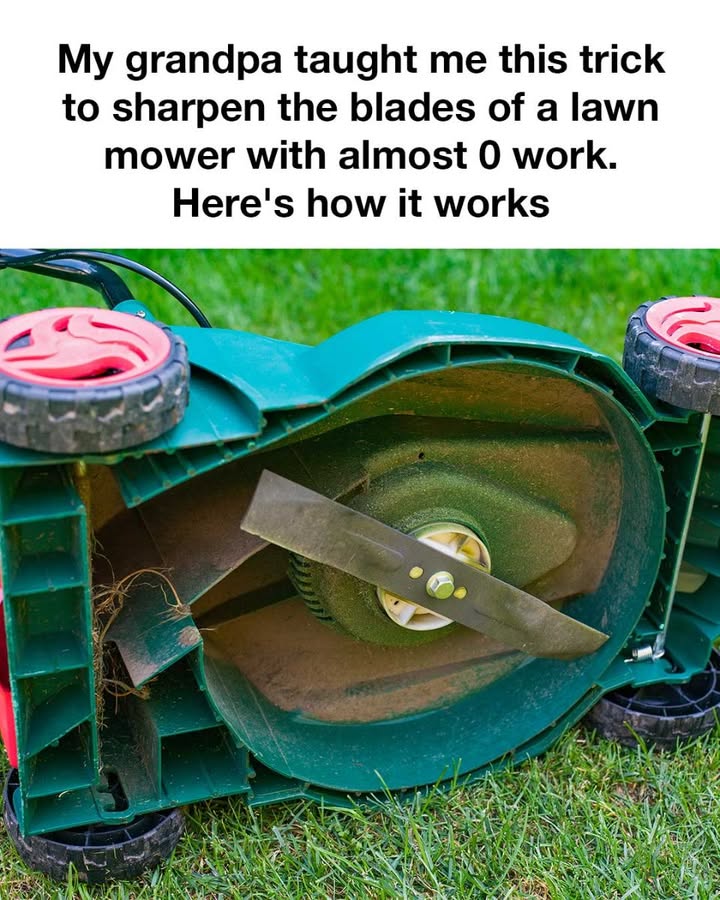
Lawn mower maintenance is an essential skill for any homeowner who values a pristine lawn. Traditionally, this involves a lot of manual labor, regular upkeep, and usually, some frustration. Many people might think maintaining a lawn mower is only about oil changes and fuel top-ups, but there’s a crucial aspect often overlooked — sharpening the blades. Dull blades can wreak havoc on your grass, tearing it instead of cutting it cleanly. Fortunately, my grandpa shared with me a family secret: an effortless trick for sharpening lawn mower blades that’s surprisingly effective.
The Importance of Sharp Blades for Lawn Care
Sharp blades ensure a clean cut of grass, which is vital for the lawn’s health and aesthetics. Dull blades tear the grass, leaving ragged edges that make your lawn susceptible to pests and diseases. Instead of creating a lush, golf course-like lawn, dull blades leave behind brown tips and weakened grass, resulting in a lackluster yard. By keeping your blades sharpened, you guarantee a healthier lawn that is more resistant to environmental stresses.
A Time-Honored Trick Passed Down Through Generations
Generations before us have found clever, simple ways to maintain their tools without the aid of modern technology. My grandpa was no exception. He devised a method that not only saved time and effort but also kept his lawn mower operating at peak performance. This trick involves minimal exertion yet yields professional results, and it’s been a family staple for years.
Materials Needed for the Blade Sharpening Trick
For this trick, you’ll need a small strip of sandpaper, WD-40 or another lubricant, a socket wrench set appropriate for your mower, and a wooden block. The key is simplicity — each item contributes to a swift and easy sharpening process without requiring specialized equipment.
Step-by-Step Guide to Sharpening Lawnmower Blades Effortlessly
1. Begin by tipping the mower onto its side, ensuring the air filter and carburetor are facing upwards to prevent fuel leakage.
2. Use the socket wrench to remove the blade from the mower.
3. Spray a light coat of WD-40 onto the sandpaper.
4. Lay the sandpaper flat on the wooden block, and gently run the blade across the sandpaper until a keen edge is achieved.
5. Once sharp, reattach the blade securely using the socket wrench. This entire process should take about 15 minutes, leaving your blades razor-sharp and ready for work.
Precautions and Safety Measures to Consider
Safety is paramount when working with sharp tools. Always wear gloves to protect your hands while handling the blade. Ensure that the lawn mower is completely turned off and disconnected from any power source before removing or handling the blade. Working slowly and deliberately will prevent accidental cuts and injuries.
Benefits of Keeping Lawnmower Blades Sharp
Sharp blades make lawn mowing more efficient and effective. They reduce the amount of strain on the mower’s engine, prolonging its lifespan and reducing fuel consumption. Additionally, the clean cuts promote healthier grass growth, providing a fuller, more vibrant lawn.
Alternative Methods of Blade Sharpening
Other than the quick sandpaper technique, lawn mower blades can be sharpened using a bench grinder, sharpening stones, or even professional services. Each has its own set of advantages but often requires either more time, money, or skill than my grandpa’s trusty method.
Common Mistakes to Avoid While Sharpening Blades
Avoid over-sharpening, which can thin the blade and lead to quicker wear. Also, always ensure that the blade is balanced after sharpening; an unbalanced blade can cause vibration and potential damage to the mower. Make sure to clean the blade and mower deck thoroughly to prevent rust from forming after use.
Conclusion: Enjoying a Perfectly Manicured Lawn
With sharp blades, your lawn mowing becomes not just a chore, but a way to enhance your home’s curb appeal and promote a healthy outdoor environment. By following my grandpa’s trick, you’ll spend less time on maintenance and more time enjoying a beautifully manicured lawn. Here’s to a greener, cleaner yard with minimal effort.





